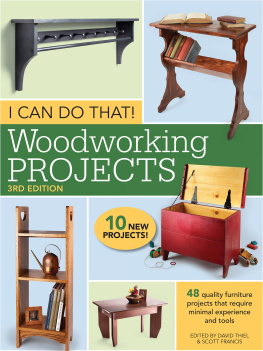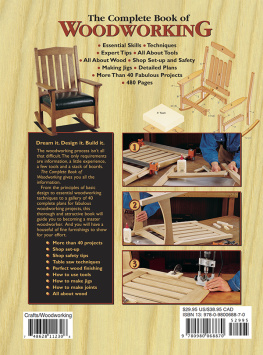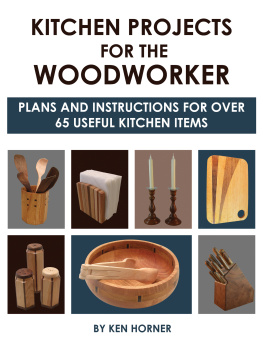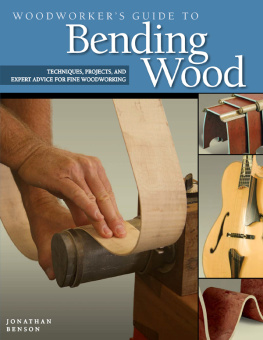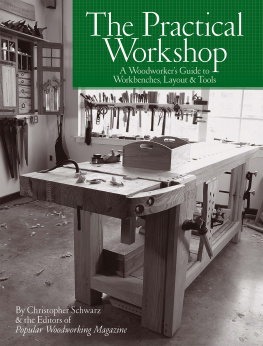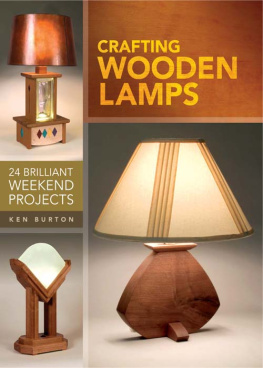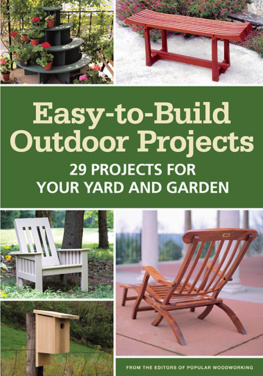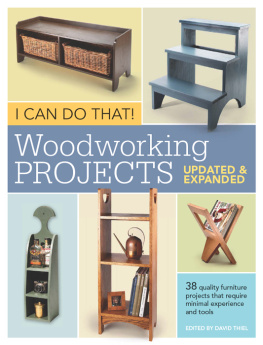



Published by Fox Chapel Publishing Company, Inc., 1970 Broad St., East Petersburg, PA 17520, 717-560-4703, www.FoxChapelPublishing.com
2011 American Woodworker. All rights reserved. No part of this publication may be reproduced in any form without written permission. Readers may create any project for personal use or sale, and may copy patterns to assist them in making projects, but may not hire others to mass-produce a project without written permission from American Woodworker. The information in this book is presented in good faith; however, no warranty is given nor are results guaranteed. American Woodworker Magazine, Fox Chapel Publishing and Woodworking Media, LLC disclaim any and all liability for untoward results.
American Woodworker, ISSN 1074-9152, USPS 738-710, is published bimonthly by Woodworking Media, LLC, 90 Sherman St., Cambridge, MA 02140, www.AmericanWoodworker.com.
Library of Congress Control Number:
ISBN-13: 978-1-56523-504-5
eISBN-13: 978-1-60765-129-1
Library of Congress Cataloging-in-Publication Data
Great book of woodworking projects : 50 projects for indoor improvements and outdoor living from the experts at American woodworker / edited by Randy Johnson.
p. cm.
Includes index.
ISBN 978-1-56523-504-5 (alk. paper)
1. Woodwork--Amateurs manuals. I. Johnson, Randy. II. American woodworker.
TT185.G7667 2011
684.08--dc22
2010025278
To learn more about the other great books from Fox Chapel Publishing, or to find a retailer near you, call toll-free 800-457-9112 or visit us at www.FoxChapelPublishing.com.
eBook version 1.0
Because working with wood and other materials inherently includes the risk of injury and damage, this book cannot guarantee that creating the projects in this book is safe for everyone. For this reason, this book is sold without warranties or guarantees of any kind, expressed or implied, and the publisher and the author disclaim any liability for any injuries, losses, or damages caused in any way by the content of this book or the readers use of the tools needed to complete the projects presented here. The publisher and the author urge all readers to thoroughly review each project and to understand the use of all tools before beginning any project.
Contents
What You Can Learn






Kitchen Improvements
A lthough the kitchen is one of the busiest rooms in a house, it often lacks enough storage for sundry pots, pans, utensils, small appliances, and cleaning supplieslet alone food. But here is some help. This section includes kitchen improvements to help you maximize your space, plus a few stand-alone projects that make storing and serving food a pleasure. For starters, youll find eight different ways to improve the storage areas in your kitchen, ranging from adding a handy pull-out trash drawer to building a mini-pantry for canned goods. The appliance garage is a favorite not only because it stores small appliances, but also because it hides other items, such as cutting boards, while keeping them close at hand. If you travel to holiday gatherings with your prize pies or cakes, then check out the portable food safe; its not only handy and attractive, its also fun to build. For a project that makes a great gift, consider the salad tongs. Spend a couple hours to make a pairor spend a day and make several.

Toe-kick drawer and pull-out trash drawer add convenience to the kitchen.
by MAC WENTZ
Simple Kitchen Upgrades
THREE EASY PROJECTS THAT ADD STORAGE, CONVENIENCE, AND SMOOTHER RUNNING DRAWERS TO YOUR KITCHEN

New Drawers and Slides
If your old drawers are coming apart, heres a way to build new boxes and save the drawer faces. Rabbeted corners and a bottom that slips into dadoes make for quick, simple, sturdy construction (Photo 1).
You can reuse the old slides, or you can upgrade to ball-bearing slides. Ball-bearing slides allow full extension and provide years of smooth, quiet service. These slides are more expensive (around $12 per set of 22-in. slides), but are worth it, especially for large or heavily loaded drawers.
If you upgrade the slides, your new box may need to be slightly different in width from the old. To determine the drawer width, carefully measure the width of the cabinet opening and subtract 1 in. to allow for the slides. The slides shown here require at least 1 in. of clearance (1/2 in. per side) and no more than 11/16 in. Since correcting a drawer thats too narrow is a lot easier than correcting one thats too wide, I allow 11/16 in. of clearance (see ). If your cabinets have face frames, youll need mounting blocks inside the cabinet to provide surfaces that are flush with the inside of the face frame (Photos 2 and 3).
Begin by ripping plywood into strips for the drawer box front, back and sides, but dont cut them to length just yet. Cut dadoes in the plywood strips by making overlapping passes with your tablesaw blade. Youre not going for a squeaky-tight fit here; the 1/4-in. plywood bottoms should slip easily into the dado.
Cut the strips to length for the drawer sides and rabbet the ends. Use the completed sides to determine the length of the front and back pieces. Cut the drawer bottoms from 1/4-in. plywood, undersizing them by about 1/16 in.
Assemble the drawer using glue at the corner joints (Photo 1). The bottom is held by dadoes, so theres no need to glue it.

Assemble and square the drawer box. For no-fuss squaring, try this: With clamps in place, nudge the drawer against a framing square and push a brad through the bottom near each corner. Unless your brad nailer shoots 3/8-in. brads, a brad pusher is the best tool for this.

Next page

